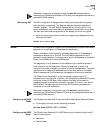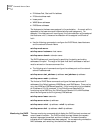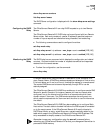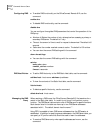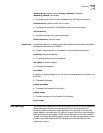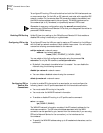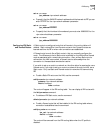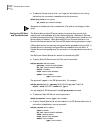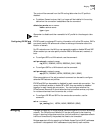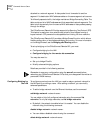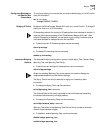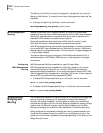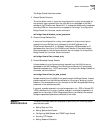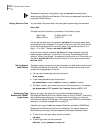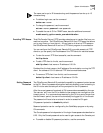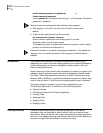
Bridging 6-19
The route will be removed from the IPX routing table when the VC profile is
disabled.
■ To delete a Framed route so that it no longer will be installed in the routing
table when the connection is established use the command:
delete ipx_service vc <vc name>
name <service name>
type <type>
Remember to disable and then re-enable the VC profile for the change to take
effect.
Configuring IPX RIP and
SAP
IPX RIP is used to exchange IPX routing information with other IPX routers. SAP is
a protocol used by IPX servers and routers to exchange information about the
location of servers.
For IPX networks over the LAN you can separately enable or disable RIP and SAP.
When enabled you can also specify whether RIPs or SAPs are sent, received, or
both.
■ To configure RIP for a LAN network, use the command:
set ipx network <network name>
rip [BOTH | DISABLE | LISTEN | RESPOND_ONLY | SEND]
■ To configure SAP for a LAN network use the command:
set ipx network <network name>
sap [BOTH | DISABLE | LISTEN | RESPOND_ONLY | SEND]
Other permutations of the set ipx network command can be used to configure
advanced RIP features and policies.
IPX RIP and SAP can be enabled or disabled for each remote site connection. You
cannot individually enable or disable RIP or SAP; they are enabled or disabled
together for each remote site connection. You can configure whether the
OfficeConnect Remote 812 should advertise local routes and services, only listen
for routes and services from the remote site, or both.
■ To configure IPX RIP and SAP for the remote site connection, use the
command:
set vc < vc name>
ipx_routing [ALL | LISTEN | NONE | RESPOND | SEND]
Bridging A bridge connects two or more physical networks together to function as one big
network. The OfficeConnect Remote 812 can be configured to be a learning
bridge. A learning bridge does more than just link networks; it separates network
traffic and forwards only the packets that need to be forwarded.
Bridges separate traffic by examining the Media Access Control (MAC) addresses
contained in data packets. MAC addresses uniquely identify each machine



